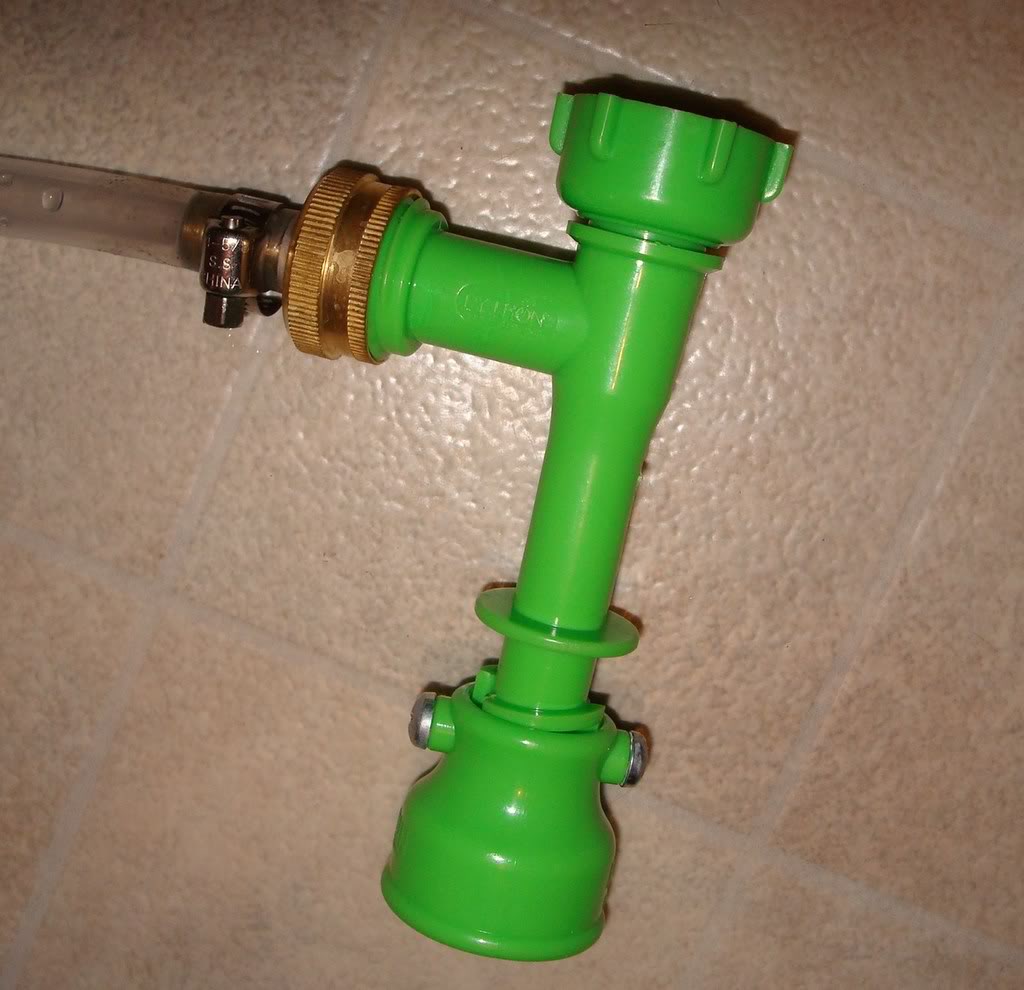I am thinking about putting together a home made Python kit myself.
I read a few articles on how to put together a DIY version. How to connect this piece to that piece etc...I don't really need any help in the parts and assembly, as different faucet need different attachments and adapters those are really not an issue for me.
What I would like is to get some input and answers on how it works and specific details. So here goes.
(1) The main Python pipe connector, the three way green thing. The one that is pictured below...ss that basically a T-connector with a shutoff at the bottom to switch from empty to fill mode? Is there any backflow control in the line that connects from the left?

(2) The way it works on EMPTYING is when you turn the faucet on, the pressure of the flow shoots straight across the T, and creates negative pressure from the side connector of the T, pulling the water from the tank, right? If so, what is it that prevents the water from just splitting into the sink and the tank and the same time? Unless the side connector has some sort of a backflow preventer in it?
(3) This would work even if the faucet is higher elevation wise compared to the tank right? I assume water would have to run continuously to keep the flow and not just use it to get started in that situation?
(4) Various adapter could be used to connect to the faucet, depending on whether the faucet has a male or female threaded aerator etc...however has anyone tried a 1/2" fernco-hose adapter and you just clamp down on it? I wonder if that would work or that would cause water to jet off the side.
(5) Can I use a normal T connector instead of the green Python connector if I can hook up a shutoff valve at the bottom? Is it not a matter of cost just I think I can build a more robust unit with brass parts.
(6) My closest sink is the kitchen sink, it's 28 feet away. The next closest sink is a bathroom sink, and it's over 35' away. My wife says there is no way I can drink "fish poop water into the kitchen sink" that is used for food preparation. So I need to drain into the bathroom sink, do you all drain into a bath sink?
(7) I also saw a few DIY kits that some built with a PVC portion on the tank side to stop it from moving or shifting when you turn the water on. If I do the same, and use PVC pipe primer and solvent that is rated for potable pipes, is that ok or still may be toxic for fish after it cures?
I read a few articles on how to put together a DIY version. How to connect this piece to that piece etc...I don't really need any help in the parts and assembly, as different faucet need different attachments and adapters those are really not an issue for me.
What I would like is to get some input and answers on how it works and specific details. So here goes.
(1) The main Python pipe connector, the three way green thing. The one that is pictured below...ss that basically a T-connector with a shutoff at the bottom to switch from empty to fill mode? Is there any backflow control in the line that connects from the left?

(2) The way it works on EMPTYING is when you turn the faucet on, the pressure of the flow shoots straight across the T, and creates negative pressure from the side connector of the T, pulling the water from the tank, right? If so, what is it that prevents the water from just splitting into the sink and the tank and the same time? Unless the side connector has some sort of a backflow preventer in it?
(3) This would work even if the faucet is higher elevation wise compared to the tank right? I assume water would have to run continuously to keep the flow and not just use it to get started in that situation?
(4) Various adapter could be used to connect to the faucet, depending on whether the faucet has a male or female threaded aerator etc...however has anyone tried a 1/2" fernco-hose adapter and you just clamp down on it? I wonder if that would work or that would cause water to jet off the side.
(5) Can I use a normal T connector instead of the green Python connector if I can hook up a shutoff valve at the bottom? Is it not a matter of cost just I think I can build a more robust unit with brass parts.
(6) My closest sink is the kitchen sink, it's 28 feet away. The next closest sink is a bathroom sink, and it's over 35' away. My wife says there is no way I can drink "fish poop water into the kitchen sink" that is used for food preparation. So I need to drain into the bathroom sink, do you all drain into a bath sink?
(7) I also saw a few DIY kits that some built with a PVC portion on the tank side to stop it from moving or shifting when you turn the water on. If I do the same, and use PVC pipe primer and solvent that is rated for potable pipes, is that ok or still may be toxic for fish after it cures?
